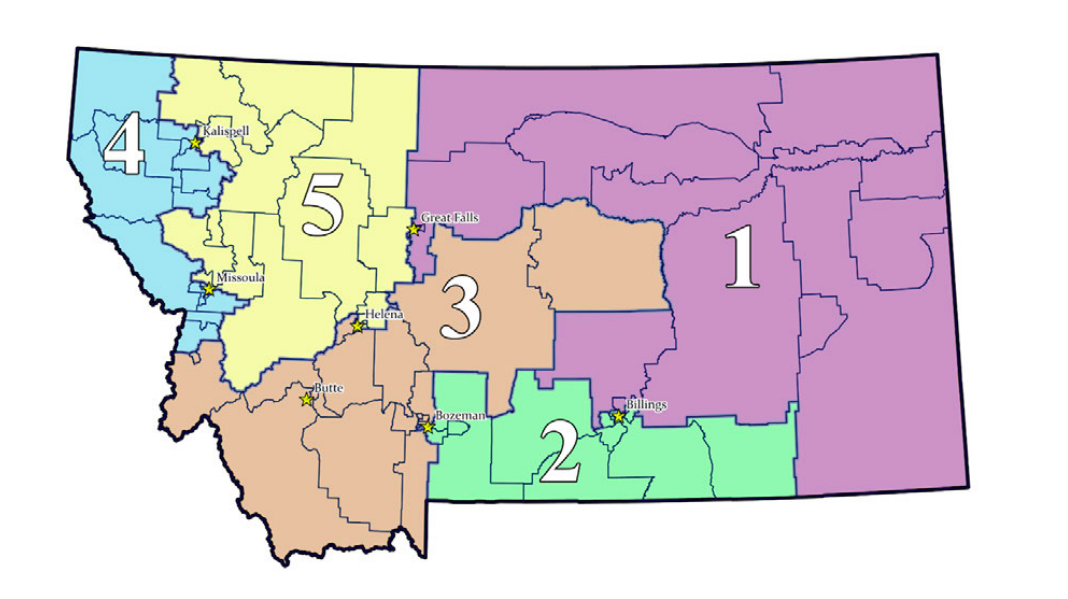Judge: Public Service Commission Map Likely Unconstitutional, but in Place for Now
Judge does not stop map, but will set expedited court schedule for gerrymander lawsuit
By KEILA SZPALLER, Daily Montanan
A Public Service Commission map that appears gerrymandered to favor Republicans is likely unconstitutional — but it will stay in place for now, according to a Lewis and Clark County District order Thursday.
However, Judge Christopher Abbott said the court will set an expedited schedule for the lawsuit over PSC districts, and he predicts the plaintiffs who allege the map is unconstitutional will win on the merits.
“Plaintiffs are likely to succeed in demonstrating that, at a minimum, Districts 3 and 5 were drawn to disfavor voters on the basis of political ideas,” the order said of the five PSC districts.
The Montana Constitution, unlike the U.S. Constitution, “expressly prohibits discrimination in the exercise of one’s civil or political rights on the basis of political ideas,” it said.
The reason the map will stay in place despite its likely flaws is because the alternative means defaulting to a map that would disadvantage a different group, Abbott said — not Democrats but voters who live in the largest districts.
In October 2023, plaintiffs the Montana Conservation Voters and eight individuals sued the Secretary of State alleging a Public Service Commission map the Montana Legislature adopted through Senate Bill 109 last spring was gerrymandered and unconstitutional.
The order Thursday denies the request from the plaintiffs for a preliminary injunction — to stop the map — and it also denies the state’s motion to dismiss the case. Plaintiffs are represented by Upper Seven Law.
However, the order discusses the reasons the map probably was illegally designed to favor Republicans and “limit the influence” of voters not inclined to vote for GOP candidates.
The order said mathematics expert Stephanie Somersille, who testified for the plaintiffs in the case, compared the legislature’s map with more than 100,000 maps, and she found it to be “an extreme outlier” with respect to partisan outcomes.
“As Democratic voter share increases statewide, one would expect Democrats to pick up progressively more PSC seats; with (the map from SB 109), however, Democratic pickups lagged substantially behind what would be predicted as statewide voter share increased,” the order said.
The order also said the Secretary of State did not meaningfully rebut Somersille’s testimony, and it noted the math expert has found maps in the past that have disadvantaged both Republicans and Democrats.
It also said delegates to the 1972 Montana Constitutional Convention wanted to “limit the influence of partisan gamesmanship on legislative district apportionment,” and their discussion should weigh on PSC maps too.
At the time, the Public Service Commission had just three members, and they were elected at large. So the delegates didn’t discuss PSC redistricting at the convention, the order said. It’s the Montana Legislature’s role to set PSC districts.
However, the judge said the debate at the constitutional convention still sheds light on the reason delegates wanted to put redistricting responsibility in the hands of a more neutral Districting and Apportionment Commission — not the legislature.
“The delegates were concerned about the pernicious effects of political gerrymandering, and its redistricting scheme for the only districted offices then in existence was consciously designed to make gerrymandering difficult to achieve,” the order said.
The order said the court doesn’t have the capacity in the available timeframe to come up with its own maps, but it also said it won’t overstep the legislature.
“The principles of separation of powers and comity towards coordinate branches of government dictate that this Court give the legislature first opportunity at curing a violation whenever possible,” the order said.
The expedited court schedule is intended to allow for a decision in the case and “hopefully” any appeal in time for the 2025 legislative session.
“If the Court’s prediction of the likely success of Plaintiffs’ claims turns into reality following a more fulsome hearing of the merits, the Court would likely retain jurisdiction over the case to review the 2025 legislature’s efforts and consider further remedies should the legislature fail to cure any deficiencies found by the Court,” the order said.
At the same time, the court acknowledged the map in SB109, sponsored by Sen. Keith Regier, R-Kalispell, did a better job of achieving population parity than a previous map imposed by judges in 2022 in separate litigation, partly because it followed House district lines, which “all but guarantees” parity.
But it didn’t meet other districting criteria and had many other problems, the order said, including splitting six of Montana’s seven largest cities, or all besides Butte; Great Falls was divided three ways.
Additionally, the order noted the math expert said the evidence “strongly suggests” the map “was made to lock in Republican advantage in all five of its districts under the most currently typical patterns of voting in Montana.”
Regier denied any knowledge of the partisan lean of the districts, the order said, but he’s just one legislator among 150, and “the record contains no information about who assisted Senator Regier in drafting the maps and what motivations they may have harbored.”
This story originally appeared in the Daily Montanan, which can be found online at dailymontanan.com.